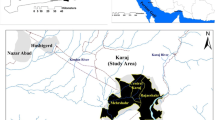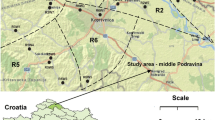Abstract
Nitrates are the most common chemical pollutant of groundwater in agricultural and suburban areas. Croatia must comply with the Nitrate Directive (91/676/EEC) whose aim is to reduce water pollution by nitrates originating from agriculture and to prevent further pollution. Podravina and Prigorje are the areas with a relatively high degree of agricultural activity. Therefore, the aim of this study was, by monitoring nitrates, to determine the distribution of nitrates in two different areas, Podravina and Prigorje (Croatia), to determine sources of contamination as well as annual and seasonal trends. The nitrate concentrations were measured in 30 wells (N = 382 samples) in Prigorje and in 19 wells (N = 174 samples) in Podravina from 2002 to 2007. In Podravina, the nitrate content was 24.9 mg/l and 6 % of the samples were above the maximum available value (MAV), and in Prigorje the content was 53.9 mg/l and 38 % of the samples above MAV. The wells were classified as correct, occasionally incorrect and incorrect. In the group of occasionally incorrect and incorrect wells, the point sources were within 10 m of the well. There is no statistically significant difference over the years or seasons within the year, but the interaction between locations and years was significant. Nitrate concentrations’ trend was not significant during the monitoring. These results are a prerequisite for the adjustment of Croatian standards to those of the EU and will contribute to the implementation of the Nitrate Directive and the Directives on Environmental Protection in Croatia and the EU.





Similar content being viewed by others
References
Aelion, C. M., & Conte, B. C. (2004). Susceptibility of residental wells to VOC and nitrate contamination. Environmental Science and Technology, 38, 1648–1653.
Atxotegi, U., Iqbal, M. Z., & Czarntzki, A. C. (2003). A preliminary assessment of nitrate degradation in simulated soil environments. Environmental Geology, 45, 161–170.
Banks, D., Frengstad, B., Midtgard, A. K., Krog, J. R., & Strand, T. (1998). The chemistry of Norwegian groundwaters: I. The distribution of radon, major and minor elements in 1604 crystalline bedrock groundwaters. The Science of the Total Environment, 222, 71–91.
Caballero Mesa, J. M., Armendariz, C. R., & Hardisson de la Torre, A. (2003). Nitrate intake from drinking water on Tenerife island (Spain). The Science of the Total Environment, 302, 85–92.
Cetindag, B. (2005). Investigation of discharge and groundwater contamination characteristics around the Karasu Spring, Mus area, Turkey. Environmental Geology, 47, 268–282.
Davis, C. S. (2002). Statistical Methods for the Analysis of Repeated Measurements. New York: Springer.
Drake, V. M., & Bauder, J. W. (2005). Ground water nitrate-nitrogen trends in relation to urban development, Helena, Montana, 1971–2003. Ground Water Monitoring & Remediation, 25, 118–130.
Elhatip, H., Afsim, M., Kuscu, I., Dirik, K., Kurmac, Y., & Kaviurmaci, M. (2003). Influences of human activities and agriculture on groundwater quality of Kayseri-Incesu-Dokuzpinar springs, central Anatolian part of Turkey. Enviromental Geology, 44, 490–494.
European Union (EU). (1991). Council Directive 91/676/EEC of 12 December 1991 concerning the protection of waters against pollution caused by nitrates from agricultural sources. Official Journal, L 375, 0001–0008.
Gardner, K. K., & Vogel, R. M. (2005). Predicting ground water nitrate concentration from land use. Ground Water, 43, 343–352.
Hallberg, G. R. (1989). Nitrates in groundwater in the United States of America. In R. F. Follet (Ed.), Nitrogen management and groundwater protection: developments in agriculture and managed-forest ecology, 21. Dordrecht: Elsevier.
Hooker, K. V., Coxon, C. E., Hackett, R., Kirwan, L. E., O’Keeffe, E., & Richards, K. G. (2008). Evaluation of cover crop and reduced cultivation for reducing nitrate leaching in Ireland. Journal of Environmental Quality, 37, 138–145.
Jalali, M. (2005). Nitrates leaching from agricultural land in Hamadan, western Iran. Agriculture, Ecosystems and Environment, 110, 210–218.
Kattan, Z. (2001). Use of hydrochemistry and environmental isotopes for evaluation of groundwater in the Paleogene limestone aquifer of the Ras Al-Ain area (Syrian Jezireh). Environmental Geology, 41, 128–144.
Kazemi, G. A. (2004). Temporal changes in the physical properties and chemical composition of the municipal water supply of Shahrood, northeastern Iran. Hydrogeology Journal, 12, 723–734.
Krapac, I. G., Dey, W. S., Roy, W. R., Smyth, C. A., Storment, E., Sargent, S. L., & Steele, J. D. (2002). Impacts of swine manure pits on groundwater quality. Environmental Pollution, 120, 475–492.
Maxwell, O., Mile, I., & Obeta, M. C. (2010). Seasonal variation in nitrate levels in hand dug wells in Makurdi Metropolis. Pakistan Journal of Nutrition, 9, 539–542.
McLay, C. D. A., Dragten, R., Sparling, G., & Selvarajah, N. (2001). Predicting groundwater nitrate concentrations in a region of mixed agricultural land use: a comparison of three approaches. Environmental Pollution, 115, 191–204.
Nemčić-Jurec, J. J., & Vadla, D. (2010). Monitoring of nitrate in drinking water in Koprivnica-Križevci County. Acta Medica Croatica, 64, 375–380.
Nemčić, J. J., Mesić, M., Bašić, F., Kisić, I., & Zgorelec, Ž. (2007). Nitrate concentration in drinking water from wells at three different locations in northwest Croatia. Cereal Research Communications, 35, 845–848.
Obeidat, M. M., Massadeh, A. M., Al-Ajlouni, A. M., & Athamneh, F. S. (2007). Analysis and evaluation of nitrate levels in groundwater at Al-Hashimiya area, Jordan. Enviromental Monitoring and Assessment, 135, 1–3.
Regulation of health safety of the drinking water (2008) NN 47/2008 SAS 9.2 (http://support.sas.com/documentation/92/index.html). Accessed 25 April 2008.
Seong-Chun, J., Gwang-Ok, B., Kang-Kun, L., & Hyung-Jae, C. (2005). Identification of the source of nitrate contamination in ground water below an agricultural site, Jeungpyeong, Korea. Journal of Environmental Quality, 34, 804–815.
Showers, W. J., Genna, B., McDade, T., Bolich, R., & Fountain, J. C. (2008). Nitrate contamination in groundwater on an urbanized dairy farm. Environmental Science and Technology, 42, 4683–4688.
Šimunić, I., Tomić, F., Mesić, M., & Kolak, I. (2002). Nitrogen leaching from meliorated soil. Die Bodenkultur, 53, 71–79.
Sparks, T. (2000). Statistics in ecotoxicology. New York: Wiley.
Statistica 8.0 (Electronic Version): StatSoft, Inc (2011). Electronic statistics textbook. Tulsa, OK: StatSoft. WEB: http://www.statsoft.com/textbook/. Accessed 1 Oct 2011.
Thorburn, P. J., Biggs, J. S., Weier, K. L., & Keating, B. A. (2003). Nitrate in groundwaters of intensive agricultural areas in coastal Northeastern Australia. Agriculture, Ecosystems and Environment, 94, 49–58.
Widory, D., Kloppman, W., Chery, L., Bonnin, J., Rochdi, H., & Guinamant, J. L. (2003). Nitrate in groundwater: an isotopic multi-tracer approach. Journal of Contaminant Hydrology, 72, 165–188.
Woo-jung, C., Gwang-Hyun, H., Sang-mo, L., Goon-Taek, L., Kwang-sik, Y., Soo-Myung, C., & Hee-Myong, R. (2007). Impact of land-use types on nitrate concentration and ó15N in unconfined groundwater in rural areas of Korea. Agriculture, Ecosystems & Environment, 120, 259–268.
Xu, J., Baker, L. A., & Johnson, P. C. (2007). Trends in ground water nitrate contamination in the Phoenix, Arizona region. Groundwater Monitoring & Remediation, 27(2), 49–56.
Author information
Authors and Affiliations
Corresponding author
Rights and permissions
About this article
Cite this article
Nemčić-Jurec, J., Konjačić, M. & Jazbec, A. Monitoring of nitrates in drinking water from agricultural and residential areas of Podravina and Prigorje (Croatia). Environ Monit Assess 185, 9509–9520 (2013). https://doi.org/10.1007/s10661-013-3269-1
Received:
Accepted:
Published:
Issue Date:
DOI: https://doi.org/10.1007/s10661-013-3269-1




